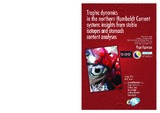Por favor, use este identificador para citar o enlazar este ítem:
https://hdl.handle.net/20.500.12958/2335| Título : | Trophic dynamics in the northern Humboldt Current system: insights from stable isotopes and stomach content analyses |
| Autor : | Espinoza, Pepe |
| Palabras clave : | Ecología Trófica;Corriente De Humboldt;Anchoveta;Engraulis Ringens Jenyns;Sardina Sardinops Sagax;Calamar Dosidicus Gigas;Alimentación |
| Fecha de publicación : | 2014 |
| Editorial : | Francia |
| Resumen : | The northern Humboldt Current system (NHCS) off Peru is one of the most productive world marine regions. It represents less than 0.1% of the world ocean surface but presently sustains about 10% of the world fish catch, with the Peruvian anchovy or anchoveta Engraulis ringens as emblematic fish resource. Compared with other eastern boundary upwelling systems, the higher fish productivity of the NHCS cannot be explained by a corresponding higher primary productivity. On another hand, the NHCS is the region where El Niño, and climate variability in general, is most notable. Also, surface oxygenated waters overlie an intense and extremely shallow Oxygen Minimum Zone (OMZ). In this context, the main objective of this study is to better understand the trophic flows in the NHCS using both stomach content and stable isotope analyses. The study focuses on a variety of organisms from low trophic levels such as zooplankton to top predators (seabirds and fur seals). The approach combines both long-term and specific studies on emblematic species such as anchoveta, and sardine Sardinops sagax and a more inclusive analysis considering the 'global' food web in the recent years (2008 – 2012) using stable isotope analysis. Revisiting anchovy and sardine we show that whereas phytoplankton largely dominated anchoveta and sardine diets in terms of numerical abundance, the carbon content of prey items indicated that zooplankton was by far the most important dietary component. Indeed for anchovy euphausiids contributed 67.5% of dietary carbon, followed by copepods (26.3%). Selecting the largest prey, the euphausiids, provide an energetic advantage for anchoveta in its ecosystem where oxygen depletion imposes strong metabolic constrain to pelagic fish. Sardine feed on smaller zooplankton than do anchoveta, with sardine diet consisting of smaller copepods and fewer euphausiids than anchoveta diet. Hence, trophic competition between sardine and anchovy in the northern Humboldt Current system is minimized by their partitioning of the zooplankton food resource based on prey size, as has been reported in other systems. These results suggest an ecological role for pelagic fish that challenges previous understanding of their position in the foodweb (zooplanktophagous instead of phytophagous), the functioning and the trophic models of the NHCS. Finally to obtain a more comprehensive vision of the relative trophic position of NHCS main components we used stable isotope analyses. For that purpose we analyzed the δ13C and δ15N stable isotope values of thirteen taxonomic categories collected off Peru from 2008 - 2011, i.e., zooplankton, fish, squids and air-breathing top predators. The δ15N isotope signature was strongly impacted by the species, the body length and the latitude. Along the Peruvian coast, the OMZ get more intense and shallow south of ~7.5ºS impacting the baseline nitrogen stable isotopes. Employing a linear mixed-effects modelling approach taking into account the latitudinal and body length effects, we provide a new vision of the relative trophic position of key ecosystem components. Also we confirm stomach content-based results on anchoveta Engraulis ringens and highlight the potential remarkable importance of an often neglected ecosystem component, the squat lobster Pleuroncodes monodon. Indeed, our results support the hypothesis according to which this species forage to some extent on fish eggs and larvae and can thus predate on the first life stages of exploited species. However, the δ13C values of these two species suggest that anchoveta and squat lobster do not exactly share the same habitat. This would potentially reduce some direct competition and/or predation. |
| Descripción : | Tesis (Doctorat Mention Biologie marine.). -- Université de Bretagne Occidentale |
| URI : | https://hdl.handle.net/20.500.12958/2335 |
| Aparece en las colecciones: | Tesis de Postgrado |
Ficheros en este ítem:
| Fichero | Descripción | Tamaño | Formato | |
|---|---|---|---|---|
| Espinoza-Pepe-PhDthesis-2014.pdf | 18,69 MB | Adobe PDF |  Visualizar/Abrir |
Este ítem está sujeto a una licencia Creative Commons Licencia Creative Commons

